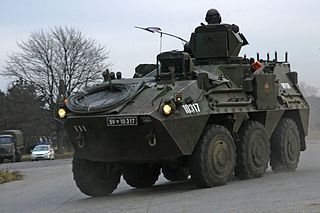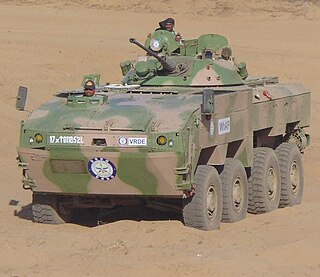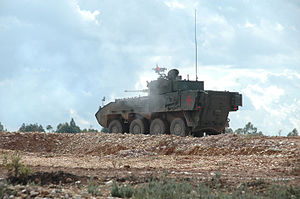
The Patria AMV is an 8×8 multi-role military vehicle produced by the Finnish defence industry company Patria.

The Mowag Piranha is a family of armoured fighting vehicles designed by the Swiss company Mowag.

The Mercedes-Benz G-Class, colloquially known as the G-Wagen is a four-wheel drive automobile manufactured by Magna Steyr in Austria and sold by Mercedes-Benz. Originally developed as a military off-roader, later more luxurious models were added to the line. In certain markets, it was sold under the Puch name as Puch G until 2000.
Steyr-Daimler-Puch was a large manufacturing conglomerate based in Steyr, Austria, which was broken up in stages between 1987 and 2001. The component parts and operations continued to exist under separate ownership and new names.

A portal axle is an off-road vehicle suspension and drive technology where the axle tube or the half-shaft is offset from – usually above – the center of the wheel hub and where driving power is transferred to each wheel via a simple gearbox, built onto each hub. It gives two advantages: ground clearance is increased, particularly beneath the low-slung differential housing of the main axles — and secondly, any hub reduction gearing allows the axle half shafts to drive the same power but at reduced torque. This reduces load on the axle crown wheel and differential.
General Dynamics Land Systems (GDLS) is a manufacturer of military vehicles such as tanks and lighter armored fighting vehicles.

The ASCOD armoured fighting vehicle family is the product of a cooperation agreement between Austrian Steyr-Daimler-Puch AG and Spanish General Dynamics Santa Bárbara Sistemas. Both companies are now divisions of a unit of General Dynamics. The ASCOD family includes the LT 105 light tank equipped with a 105 mm gun, a surface-to-air missile launcher, an anti-tank guided missile launcher, mortar carrier, R&R vehicle, command-and-control vehicle, ambulance, artillery observer, and the AIFV model.

The Pandur is an APC developed and produced by the Austrian company Steyr-Daimler-Puch Spezialfahrzeuge (SSF). It was developed during the 1980s as a private venture. In 2003, General Dynamics took over Steyr-Daimler-Puch which is now part of General Dynamics European Land Systems, which is also the parent company of MOWAG, Santa Bárbara Sistemas and GD ELS – Germany.

Lahko kolesno oklepno vozilo Valuk is an improved version of Pandur 6X6 APC, manufactured under a license manufacturing agreement with the Austrian company, Steyr Daimler Puch Spezialfahrzeug AG & Co KG, by Sistemska Tehnika of Slovenia for the Slovenian Army.

The Pars is an amphibious armoured combat vehicle family with 4x4, 6×6 and 8×8 versions, produced by FNSS Defence Systems of Turkey.

The VBTP-MR Guarani is a 6×6 armoured personnel carrier developed by Iveco and the Brazilian Army as part of its "Urutu-III" modernization program aimed to replace all EE-11 Urutu by 2015. The 8×8 version of the VBTP-MR is the base of Iveco's Superav armoured personnel carrier. Other Brazilian companies also participated in the program, such as IMBEL (Communications), Elbit (Armaments), Usiminas and Villares.

Rheinmetall MAN Military Vehicles GmbH (RMMV) is a joint venture company between German companies MAN Truck & Bus AG and Rheinmetall AG. RMMV is part of Rheinmetall's Vehicle Systems Division. Rheinmetall AG holds a 51% stake in RMMV, with the remaining 49% held by MAN Truck & Bus. RMMV was initially a provider to security and armed forces of a wide range of armoured and unarmoured transport, command and role-specific wheeled vehicles, but since 2019 and a restructure has focused on military specific and militarised commercial trucks.

The Pinzgauer is a family of high-mobility all-terrain 4WD (4×4) and 6WD (6×6) military utility vehicles. The vehicle was originally developed in the late 1960s and manufactured by Steyr-Daimler-Puch of Graz, Austria, and was named after the Pinzgauer, an Austrian breed of cattle. They were most recently manufactured at Guildford in Surrey, England by BAE Systems Land & Armaments. It was popular amongst military buyers, and continued in production there throughout the rest of the century.

The TATA Kestrel, also known as the IPMV , is a family of armoured personnel carriers developed by Tata Advanced Systems and the Defence Research and Development Organisation (DRDO). It was developed to replace Soviet-era BMP-1 and BMP-2 and APCs in service with the Indian Army.

The Tatra 815-7 is a heavy army logistics vehicle made by the Czech company Tatra produced since 2007. T817 is primarily intended for military operators and for specialist roles in civilian sector. The truck is made primarily with axle variations of 4×4, 6×6, 8×8 and 10×10. Other chassis variants up to 16x16 are also available.

The LAV II is the second generation of the Light Armoured Vehicle (LAV) family. The LAV II is an 8×8 vehicle unlike the 6×6 Armoured Vehicle General Purpose, which is a LAV based on the Piranha I. The United States Marine Corps was the first user of the LAV II, which it calls the LAV-25. Canada procured two main variants: the Coyote Reconnaissance Vehicle and the Bison armoured utility vehicle. LAV IIs in Australia are known as the ASLAV.

The Sabrah light tank is series of armored fighting vehicles developed by Elbit Systems to cater to the Philippine Army's light tank/tank destroyer requirement. The tracked light tank configuration is based on ASCOD 2 platform, supplied by Spanish manufacturer GDELS - Santa Bárbara Sistemas. The wheeled light tank configuration is based on the 8×8 Pandur II platform supplied by the Czech manufacturer Excalibur Army. Elbit Systems received a three-year contract worth $172m to supply the Sabrah light tanks to the Philippine Army in January 2021.
General Dynamics European Land Systems (GDLS) is an automotive and arms manufacturer spread across Europe, with a headquarter in Madrid, Spain. It is a business unit of General Dynamics which consolidated in one structure all European subsidiaries of GDLS.




















